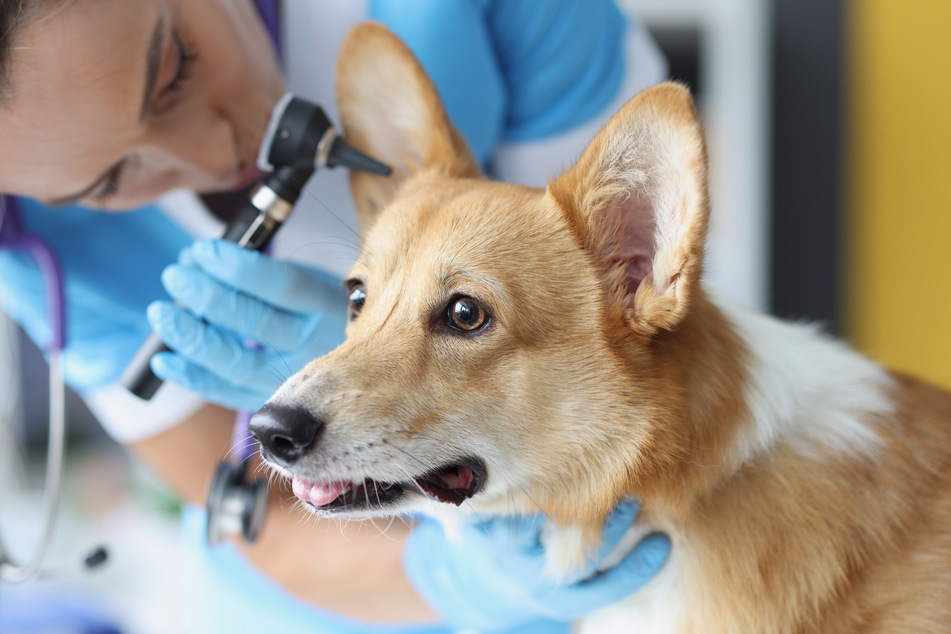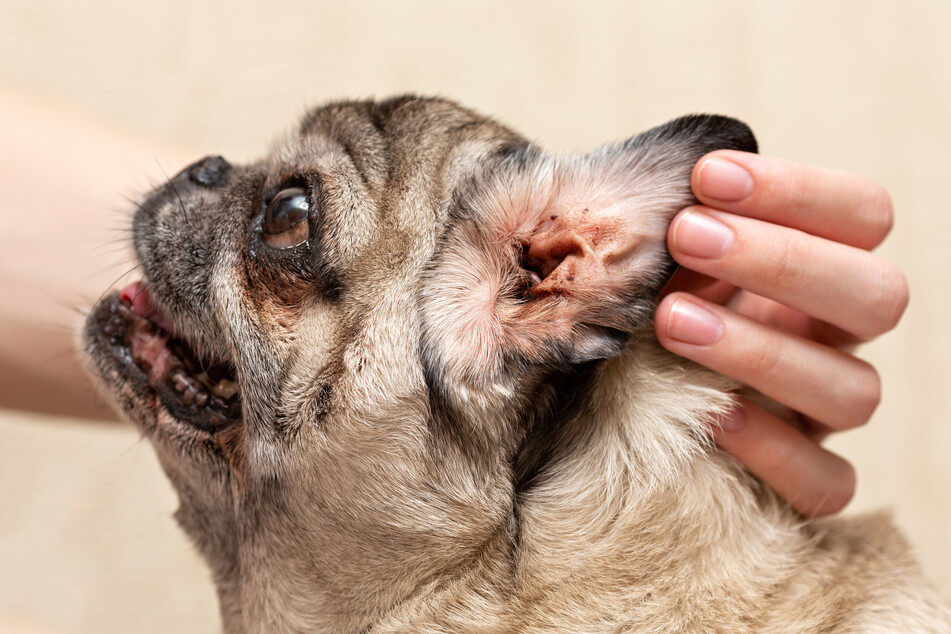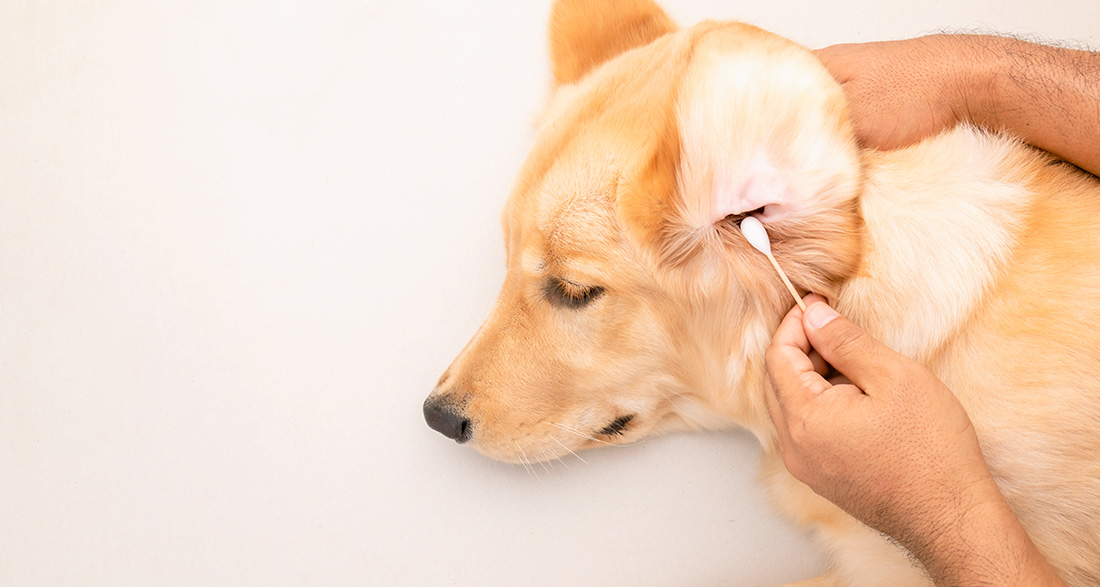Dogs’ ears are sensitive: to keep your furry friend healthy, proper care is essential. The iHugDogs guide reveals the right way to clean dog ears.
If your dog scratches its ear, shakes its head, or frequently tilts its snout upward, these could be signs of a serious ear condition.
Infections, mites, or yeast: cleaning dog ears can prevent various diseases. However, it’s crucial to handle the dog’s delicate ears with care.
Dog ears actually clean themselves. However, if the ear environment is disrupted by external stimuli, inflammation, or pests, additional cleaning and care are necessary. Besides products from pet stores, home remedies can also be effective.
Depending on the breed, dog ears may require special attention. There are differences between floppy ears and short ears, as well as among various coat types.
Learn how to clean dog ears properly in the following.
Caution
If a dog’s ears are heavily red and inflamed, or if you suspect an infestation of pests like mites, a veterinarian should be consulted.
Quick Facts:
- Dog ears clean themselves.
- The cleaning process varies depending on the breed.
- Neglecting ear care leads to diseases.
- Ear care must be done gently.
- Products from pet supply stores facilitate ear care.
- Home remedies can be effective.
- In case of doubt, consult a veterinarian.
How to Clean and Care for Dog Ears
Regularly cleaning dog ears can prevent diseases and infections. The frequency of ear cleaning depends on the breed and potential pre-existing conditions such as allergies.
While, in general, a weekly to monthly ear cleaning is sufficient, the following will outline which dog breeds require more attention in ear care.
3 Methods of Ear Cleaning for Dogs
For proper ear cleaning in dogs, there are three different methods:
- With a cotton cloth: Use a lint-free cloth. Moisten the cotton cloth with lukewarm water. Wrap it around a finger and gently wipe the inner ear flap of the dog, removing earwax. Earwax appears as brown secretion.
- With liquid ear cleaner: Purchase liquid ear cleaner from a pet store. Following the instructions, drop the liquid ear cleaner into the dog’s ear and gently massage it. The cleaner softens the existing wax. When the dog shakes its head, the dirt is expelled. Residues can also be wiped away with a damp cotton cloth.
- With ear cleaner pads: Also available in pet stores. The cleaning pads contain nourishing substances like Aloe Vera, effectively loosening stubborn dirt in the dog’s ear. Wrap the pad around your finger and gently wipe the dog’s ear.
Additionally, during ear hygiene, regularly remove hair from the ear canal. This can be done with some practice and caution at home or, alternatively, by a veterinarian or a professional dog groomer.
Mistakes to Avoid When Cleaning Dog Ears
- Timing: Always proceed with caution when cleaning dog ears. If the dog is restless or wriggling, injuries can occur quickly. Therefore, choose the right moment. If your dog is not a fan of extensive grooming, ear drops may be a better cleaning option.
- Cotton Swabs: Cotton swabs can cause severe injuries to a dog’s ear. Whether inserted too deep into the ear canal or slipping off due to the dog shaking its head: Instead of cotton swabs, opt for a lint-free cotton cloth.
- Cleaning Intensity: Gently slide the cotton cloth or pad over the inner ear flap. Never press too hard or wipe frantically.
Tip: Let the cleaner soak a bit longer if the impurities prove stubborn.
Cleaning Dog Ears with Home Remedies
Dog ears can also be cleaned with household items.
To clean the ear, consider using natural substances such as:
- Coconut oil
- Olive oil
- Aloe Vera
For application, use a lint-free cotton cloth. Notably, coconut oil is not only effective for cleaning dog ears but also helps repel pests like ticks and fleas.

Identifying Diseases in Dog Ears
If a dog constantly scratches its ear, shakes its head, or tries to put its paws in its ear, these could be signs of illness. Neglected hygiene in the ear canal can lead to inflammation, potentially resulting in hearing loss.
Additionally, watch out for pests like ticks, fleas, or mites. The smell emanating from the ear can also provide clues about an ear condition. If the ear smells excessively sweet or if black dirt is present in the dog’s ears, it could indicate a yeast infection in the dog’s ear.
The following diseases can affect a dog’s ears:
- Bacterial infections
- Itching/scratching
- Ticks
- Awns (especially in summer and fall)
- Mites
- Inflammations
- Yeast/fungus
- Allergies to food or environmental stimuli
With some practice, ticks in a dog’s ear can be removed at home. Fleas can also be treated at home in the early stages.
Caution
If uncertain about the treatment or the cause of the symptoms, it is recommended to err on the side of caution and consult a veterinarian.

Cleaning Dog Ears: Breeds Requiring Extra Care
The frequency of cleaning dog ears depends on both the breed and the degree of dirtiness.
- Bichon Frisé and Poodle: For dogs with curly fur like Bichon Frisé or Poodle, regular checks for fur in the ear canal are necessary. The curly hair structure, combined with normal earwax, can quickly lead to inflammation, literally blocking the ear canal.
- Dachshund, Beagle, and Others: For dogs with floppy or hanging ears like Bassets, Dachshunds, or Beagles, there is a greater risk of picking up pests or plant particles such as awns. Therefore, daily ear checks are advisable.
- Dogs with Allergies: If a dog is prone to allergies, daily ear cleaning should not be forgotten. This ensures their safety.
Conclusion: Remove Earwax and Fur from Dog Ears
In general, dog ears clean themselves. Nevertheless, regular checks should be conducted to remove excess earwax and fur and to inspect for symptoms of disease and pests.
This keeps the dog’s ears consistently well-maintained, protecting the beloved pet from diseases. And the best part: All you need is lukewarm water and a lint-free cloth.


